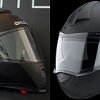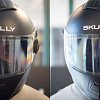Many readers here have probably seen this video on a helmet called the AR-1 with a heads-up display (HUD) from a brand named Skully. Since the video's release nine months ago, it has been watched almost 650,000 times and well over 100,000 of you have signed up for their beta tester program.
Anyone can have a great idea, make a YouTube video promising lots of cool new technology, and create buzz. Unfortunately, few can pull off a truly revolutionary product. The big question is: Did they strap a Gameboy screen into a crappy $100 helmet and add Bluetooth so it connects to your phone, or have they come up with something truly cutting edge? I was going to have to get my hands on one to begin to figure it out.
Disclaimer: Unfortunately, due to Skully’s startup nature, and lack of bajillion dollar insurance policy, I wasn’t allowed to actually ride in the AR-1 prototype. I know, I was bummed too, but no amount of threatening or pleading would get these guys to budge on risking their entire company and lives on nothing terrible happening to me. At least it's nice to know the guys behind all this are pretty smart.

I’ve never heard of Skully or the AR-1 — what is it?
The AR-1 (AR stands for Augmented Reality) is the first helmet from the team at Skully and features the first HUD system available for a motorcycle helmet. Its two main features are its 180-degree, rear-facing camera, and a little screen placed in the bottom right portion of your field of view. The screen allows you to see everything behind you, no matter which direction your helmet is facing, without any blind spots. Skully has also developed its own interface to bring turn-by-turn directions and a few other basic pieces of information to the screen, all with the purpose of reducing the mental load placed on the rider. Connectivity will come through pairing with your phone via Bluetooth, but that doesn’t mean you’ll be relying on Siri, necessarily. The Skully guys say they're working on their own voice-recognition software to improve your access to the AR-1's abilities while riding. There are also plenty of extra applications for things like track riding, where Skully is working on bringing things like speed, rpm, and other figures to the little screen.
First impressions
My first impression of the AR-1 is that it's an incredibly nice-looking motorcycle helmet. It’s easy for guys like us (geeks and journalists) to get caught up in the numbers on the page and make light of what any specific product makes you feel. Skully, however, has created something that really makes you think, “That’s badass, I want that.” The shape has some of the design language of the latest AGV or Shoei helmets, with its lowered chin bar and rear spoiler, and the matte black finish is just beautiful.

The helmet shell itself and hardware, such as face shield hinges, did not impress me as incredibly high-spec, however. I am hoping they’re using a fairly budget shell while in this stage of testing. No reason to spend a ton of money on the shells you’re about to cut apart and use basically as an outline. That said, this is one area I will definitely be watching when we get our hands on production units. I think consumers who shell out a lot of money for a tech-heavy helmet will not be happy if it feels cheap in lesser ways.
The first thing most of the other helmet companies point to when I ask them about Skully is the weight. Adding a camera, screen, batteries, and a little computer to run it all has got to be really heavy. Skully didn’t have official numbers for me, but holding both the AR-1 and my Schuberth C3-Pro (with the SRC-System communications equipment installed) revealed no real detectable differences. However, the weight on the Skully is higher up on the helmet. They hide all that tech in the rear spoiler. So it will probably feel different than the Schuberth, whose weight is centered lower. Skully claims the location of the weight will actually make it less noticeable, but I want to try riding with the helmet before I’m convinced of that.

The little cube that houses the screen is a nice piece of tech too. It moves forward and back, and swivels slightly so you can make sure the display inside is right where you need it to be. The screen is actually quite a bit smaller than the one in the video, which is just a rendering. Skully says they've not only done pretty extensive testing, but also that they've worked closely with the National Highway Traffic Safety Administration (NHTSA) to meet or exceed their guidelines for in-vehicle infotainment systems. They've also gotten a lot of feedback from military fighter pilots to create an experience that provides the best ratio of open vision to screen, as well as giving you the optimal amount of information. The screen is designed so that your eyes don't need to re-focus when looking from the road to the screen, or vice versa.
The liner used in the AR-1 was created by a company called Outlast. Originally created for NASA, the material is designed to either absorb, store, or release heat, depending on the ambient temperature. Outlast is not a sweat-wicking technology, but is meant to help control the temperature to keep you from sweating in the first place.
Equally innovative is the new face shield, which uses an electrochromatic liquid crystal technology called e-Tint, originally created by a company called AlphaMicron for the military and now adapted for commercial use. It lets the rider switch the visor between tinted and un-tinted at the push of a button. Skull is still figuring out the final aesthetics of how to integrate the button, but it was fantastic to use. The smoke tint felt dark enough to block the sun, though not too dark to be unsafe on cloudy days. Skully says this shield will come as standard equipment on the AR-1.

More importantly
The biggest takeaway from my time with the Skully team came more from my time with the guys than the helmet itself. It’s so easy to get caught up in the coolness of a product like this, but I became increasingly reassured about both the importance of HUD technology, as well as this start-up's ability to actually execute the product, as we discussed all of the angles they were looking at, especially when it came to safety. Instead of designing a helmet from scratch, they were able to get helmet designs that are already DOT-approved from one of the major factories that produces helmets for a variety of other brands. The rear spoiler that contains the camera and processor is designed to break off instantly on impact, so it doesn’t affect the way your head may potentially hit the pavement. As I mentioned, they’ve put a ton of effort into making sure the display is easy to reference without losing sight of road in front of you, and most of the interface is designed to give you just the information you need while riding, instead of all of the information possible.
The helmet I was able to play with is still a prototype, and one of the reasons I was able to get an early peek was because Skully wanted my feedback on ways they could improve it. The unit I held was a good start, but they still have even more refinements and tweaks in the coming months. Most of them I’ve been asked not to share, but I can say they are all things that will make the features just work better and a few of them are just plain awesome. They were already aware of, and had begun to address, the less-than-stellar aspects I pointed out. I really appreciate that they're trying to consider all of the angles and answer all of the questions around making this product do the best job possible. The team from Skully says to look for a major announcement around the beginning of August and that we should start seeing Skully helmets available within the first part of next year.
So how much will all this cost?
Skully took another big step toward making the product a reality this week. The Skully crowdfunding campaign launched on Indiegogo on Monday, and when I last checked on Tuesday, it had already raised $952,062 (their goal was $250,000). Through the campaign, pre-orderers were able to buy an AR-1 for $1,299, $200 less than the $1,499 they will retail for when launched next year.
There's no doubt that price will give many of you sticker shock. New technology is always expensive. Plasma TVs once cost $10,000 and infotainment systems used to come only in luxury cars. But we have also seen that if new companies can sell enough product to stay afloat, the cost of the new technology can fall dramatically over time as they scale up.

Conclusion
So, to answer my initial question: The team at Skully has definitely thought this endeavor through. They've looked at not only what they can do, but also what is wise to do. They're attempting to marry some incredible enhancements with a quality and usability that is focused on real-world use and for that, I applaud them. They have the right ideas and are working with the right people and you can be sure we'll be following this closely.
Here's another marketing video Skully recently produced that shows a little more of the helmet's capabilities.














